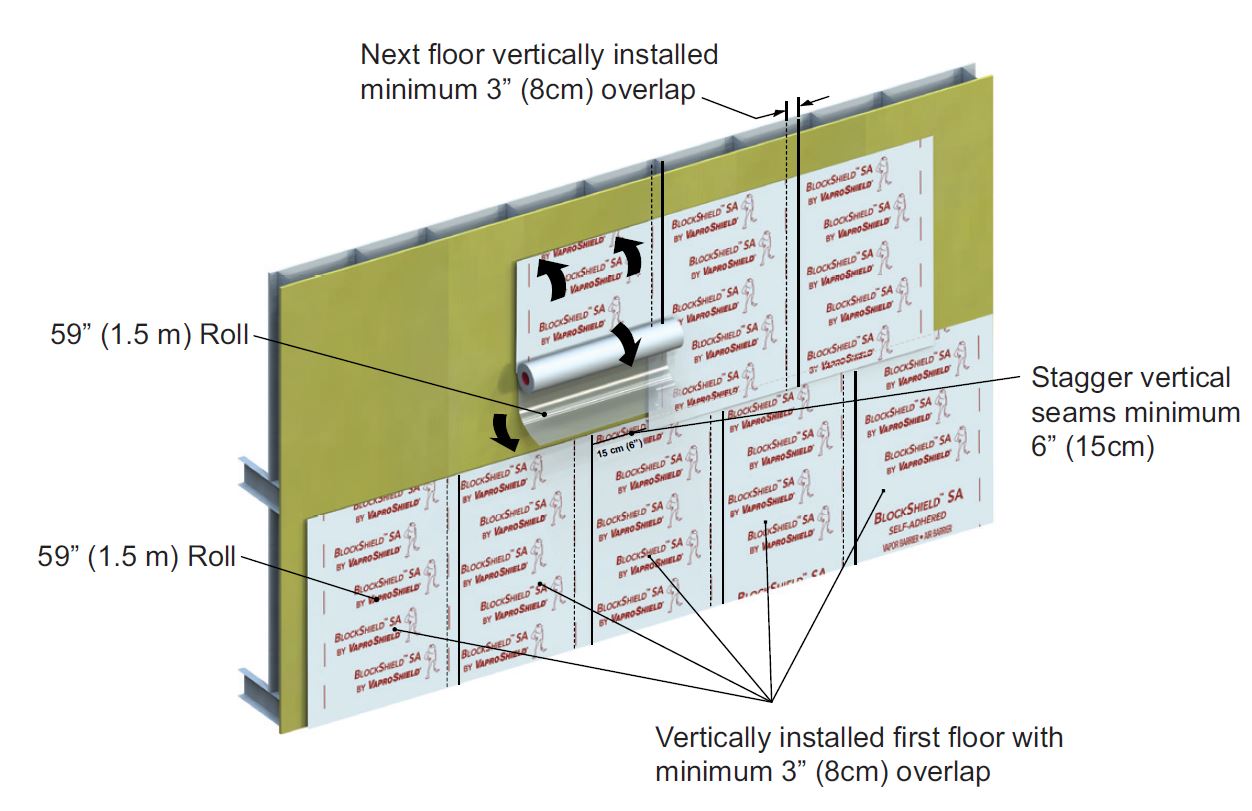Overview
BlockShield SA is a self-adhered, non-asphaltic, durable, air, water, and vapor barrier membrane with an aggressive pressure-sensitive adhesive that does not require a primer and is easily applied to most construction substrates. Designed for use in commercial and residential construction applications, BlockShield SA creates a barrier against water, air, and moisture infiltration when applied in a rainscreen assembly behind exterior cladding. BlockShield SA consists of a proprietary film with a pressure-sensitive adhesive.
Installation Best Practices
- BlockShield SA installation layout should be planned prior to application to minimize waste, this process will assist locating penetrations that will need to be correctly detailed to ensure a water and airtight installation.
- During the installation process, BlockShield SA must be protected at the leading edge to ensure liquid water does not travel behind the membrane.
- BlockShield SA can be installed in a vertical or horizontal direction.
- Membrane is easily cut to size with basic hand tools.
- Always install in a “weatherboard or shingle fashion” with the upper courses lapped over the lower courses
- All penetrations including windows and doors must be installed in proper sequence to ensure a “weatherboard or shingle fashion” result.
- All overlaps must be a minimum of 3” (8 cm) on vertical and horizontal seams. Inside and outside vertical corner overlaps should be a minimum 6” (15 cm) in both directions.
- Vertical seams should be staggered a minimum of 6" (15 cm) and should not occur directly above or below windows or doors.
- Vertical seams should be staggered from floor-to-floor or separated by a BlockFlashing horizontally applied strip.
- Roll membrane with two-handed roller to ensure proper adhesion to substrate.
- If desired adhesion is not attained between membranes due to site conditions, VaproShield recommends applying a bead of VaproBond as an additional solution to pressure rolling.
Sustains a maximum twelve (12) months UV and climate exposure prior to cladding installation.
Storage
Store material in original packaging. Protect rolls from direct sunlight and inclement weather until ready for use.
Substrate Information
Substrates must be clean and free of any contaminants.
Substrate surface must be dry to the touch with the ambient temperature above 20°F (-6.6°C).
PRIMER IS NOT RECOMMENDED OR REQUIRED
Substrates
- Exterior Gypsum Sheathing
- Brick
- Rigid Insulation
- Plywood
- OSB
- Metal (Steel, Aluminum)
- Concrete
- Fiberglass and Vinyl Window and Door Frames
Adhesive Curing Time
Full adhesion will vary depending on job site weather conditions. Curing will continue to occur for up to 48 hours.
Floor Line Movement
Buildings are designed to accommodate thermal and seismic movement.
BlockShield SA must be installed to allow this movement throughout the life of the structure.
To accommodate floor-line movement: Limit coverage area to a single floor and shingle subsequent layers over the top leading edge. See BlockShield SA details page for floor line movement applications.
Penetrations
Window and door penetrations can be detailed pre or post installation of the field membrane.
Always ensure shingle fashion result is achieved.
Original Packaging Functions as Dispenser
- Keep BlockShield SA in original packaging carefully lift one end of the product out of the box and slide the plastic wrap towards the opposite end.
- Insert roll into end.
- Replace the roll in the box/dispenser and carefully remove the tape in the middle of the roll.
MANAGEABLE LENGTHS
Pre-cut material into individual manageable lengths by pulling material off the main roll to desired length.
Cut material square to the factory edges.
Re-roll material same direction it came off the roll, with the release film outward.
Cut material to desired length with extended blade razor knife.
Single Worker vs. Two Worker Installation
Using the material at its full width, 59” (1.5 m), vertical installation can be easily accomplished by a single worker.
Horizontal installation of the full width material is best accomplished by two workers.
Partial width rolls are easily installed by a single worker.
View details of installation sequence and videos.
Best Practice Installation Techniques
- Snap a level chalk line for guidance
- Pre-cut material to desired length
- Roll material with release film facing OUTWARD
- Starting at a corner of the roll, peel back approx. 6” (15 cm) of release film
- Fold the release film back on to itself carefully, leaving approximately 6" exposed
- Using hand pressure, lightly apply the exposed adhesive surface to the substrate and check for proper alignment. Reposition if needed
Vertical Installation Technique
- Allow the rolled up material to drop down the wall, with the remainder of the release film still attached, checking for proper alignment. Reposition if needed
- When aligned, apply heavy hand pressure across the entire adhered section
- Slowly pull the release film down the wall, keeping the release film against the substrate to avoid air bubbles
- Lightly smooth out air bubbles with wallpaper trowel or by hand
- Continue until all the release film has been removed
- Roll membrane with two-handed roller to ensure proper adhesion to substrate
- Install next section, ensuring a 3" (8 cm) minimum overlap to the adjoining material, always in a shingle fashion
Installation Tips
- Avoid scoring the membrane at locations where the material overlaps onto the adjacent piece
- Allow the top layer of material to span across the underlying layer without attempting to force the material into a 90° bend
- Avoid stretching the material during installation at inside and outside corners
- A full 6” (15 cm) overlap in either direction is recommended vertically at inside and outside corners
Warranty Information pdf (369 KB)
pdf View warranty request form here. (369 KB)
Installation Best Practices
Note: This shows multiple installation techniques for vertical and horizontal.
Vertical Installation |
Multi-Floor Vertical Overlap |
Vertical Installation Horizontal Floor Line |
Horizontal Installation |






